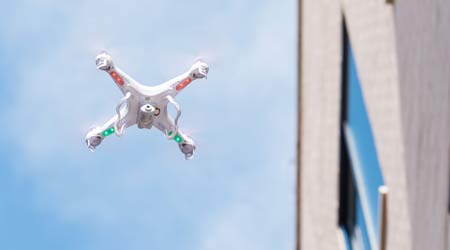 Drones can be used to inspect hard-to-reach areas of building exteriors.
Drones can be used to inspect hard-to-reach areas of building exteriors.Drones: An Opportunity and a Challenge
Drones can multiple useful applications for facility management, but those facility managers who take precautions will have the most success - and limit potential harm.
Since drones — more formally, unmanned aircraft systems or UAS — targeted to consumers were introduced in about 2010, they’ve become more numerous, more affordable, and more sophisticated. That presents both opportunities and risks for facility managers and building owners.
On the positive side, drones can be used to improve building maintenance. For instance, after hurricanes, a facility manager can use infrared cameras attached to drones to check for roof saturation, says David Cheyne, senior associate with Wiss, Janney, Elstner Associates, Inc. Areas not saturated cool down faster, and the infrared camera can identify this.
In all cases, however, the Federal Aviation Administration requires operators to keep drones within their line of sight. So, while a drone can minimize the need to walk across a roof, the operator should monitor the device as it goes about its work.
FAA also requires drones deployed for commercial use be registered under the agency’s small UAS rule, and the operator to have a remote pilot certificate.
Many cities are adopting laws similar to the FAA regulations, Cheyne says. FAA lacks the staffing it would need to ensure widespread enforcement. To link Federal and local law, many cities are incorporating FAA Part 107 (which covers small unmanned aircraft) flight restrictions into local ordinances, allocating penalties accordingly, he says.
Before deploying drones for maintenance or other operational reasons, it also makes sense to alert your insurance carriers, says James Acevedo, president of StarRiver Inc., a security consultancy. Some don’t cover drone damage.
Intentional drone damage
While drones hold the potential to improve building maintenance, they also have a negative side. “The trouble occurs when people misuse them,” says Sean Ahrens, security market group leader with Affiliated Engineers.
This can be accidental. Say someone is flying a drone in an urban area and inadvertently steers it into a building. Chances are, it’s going to come tumbling down, and potentially hit someone. “These are people who aren’t intending to do harm, but are just ignorant,” Ahrens says.
A first step in mitigating this risk is posting a notice that using drones on the building premises is not allowed, Ahrens says. This serves as initial notice to occupants and others that drone use is not permitted. While this probably won’t stop a determined aggressor, it might prevent problems that arise from misuse, he adds.
The potential for more sinister drone applications also is cause for concern. “When it comes to drones, you can do almost anything you want,” Acevedo says. This includes, for instance, using a drone to hack into a server farm or phone.
“A drone is a path of least resistance,” Ahrens says. An aggressor could use a drone to initiate an act that requires little investment or planning, but that has a significant and negative impact.
Facility managers should assess the risk that drones could inflict harm on their property or tenants, Acevedo says. What activities take place in the building? Would someone have a reason to exploit them? If so, how can you mitigate the risk?
For instance, if the tenant roster includes law, financial, or other firms likely to conduct sensitive conversations, they’ll want to watch for drones near the building that are equipped with audio or video equipment and could pick up their discussions. While such a scenario may sound far-fetched, the technology already exists.
“Because of the simplicity of the technology, it can be adapted to almost anything, good and bad,” Acevedo says. A few precautions can limit the risk a drone operator harms, intentionally or not, a building or its occupants.
Karen Kroll, a contributing editor for Building Operating Management, has written extensively about real estate and facility issues.
Email comments and questions to edward.sullivan@tradepress.com.
Related Topics:


















